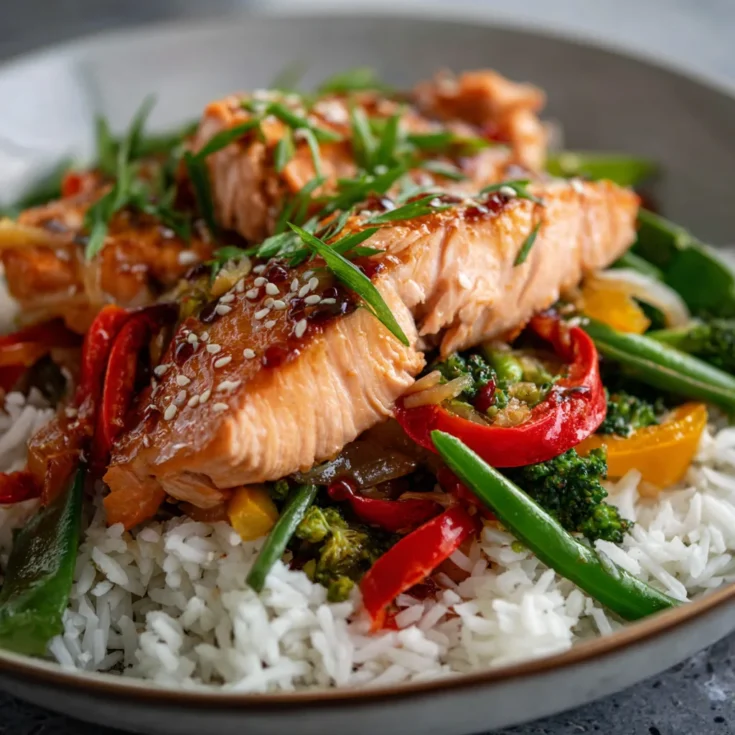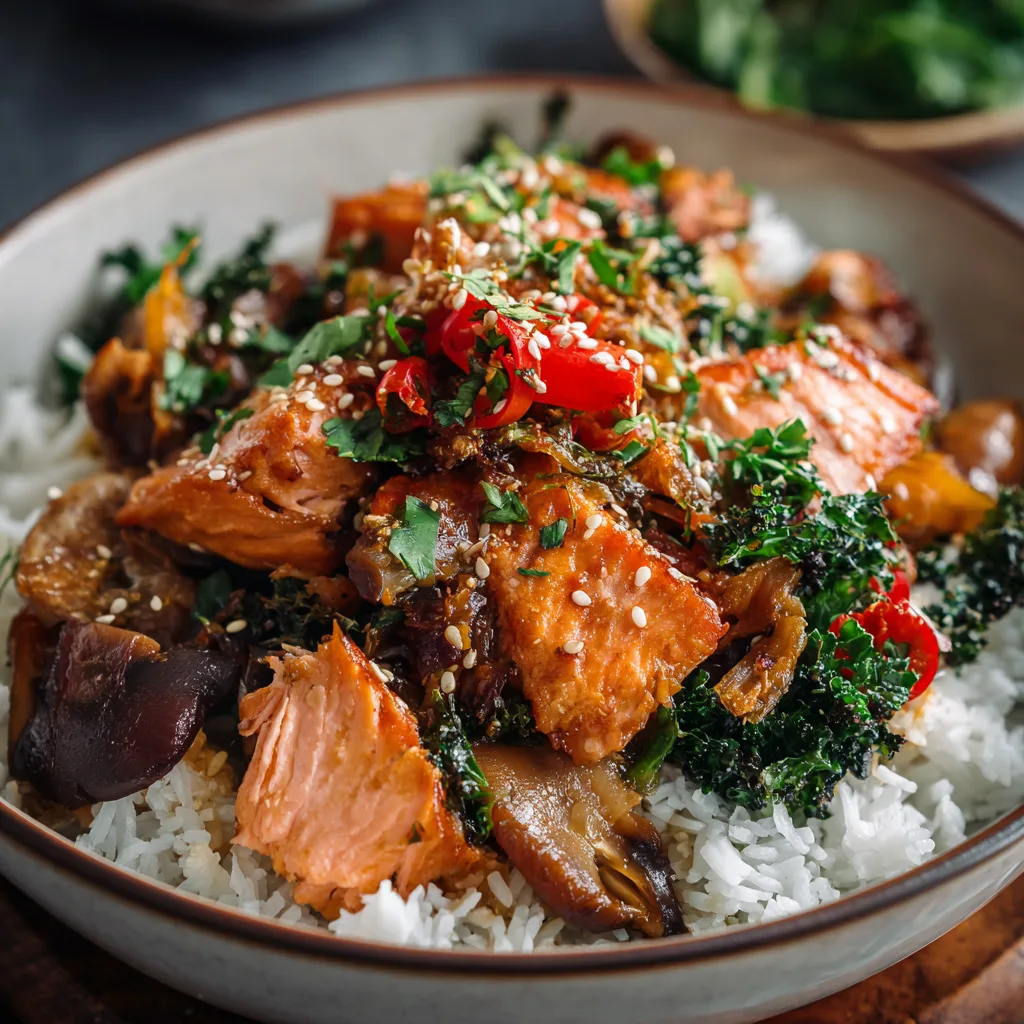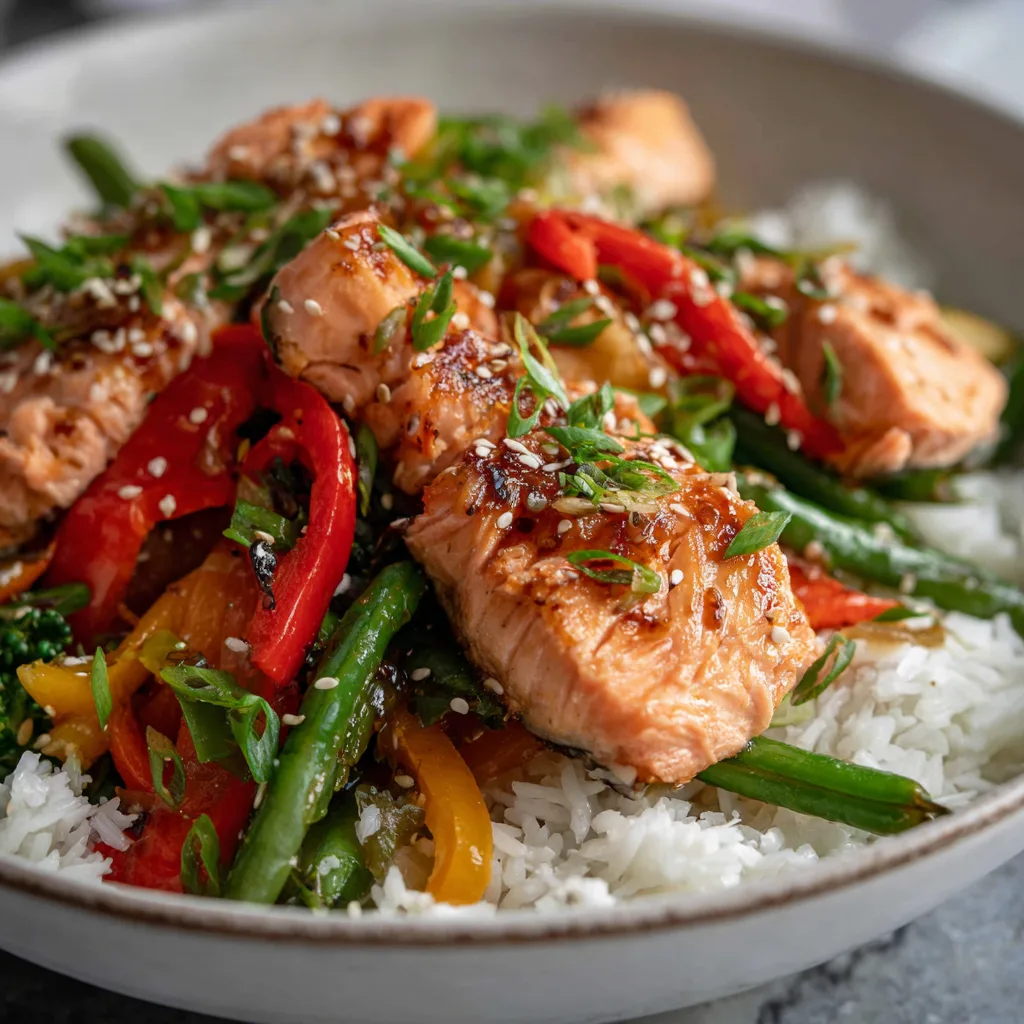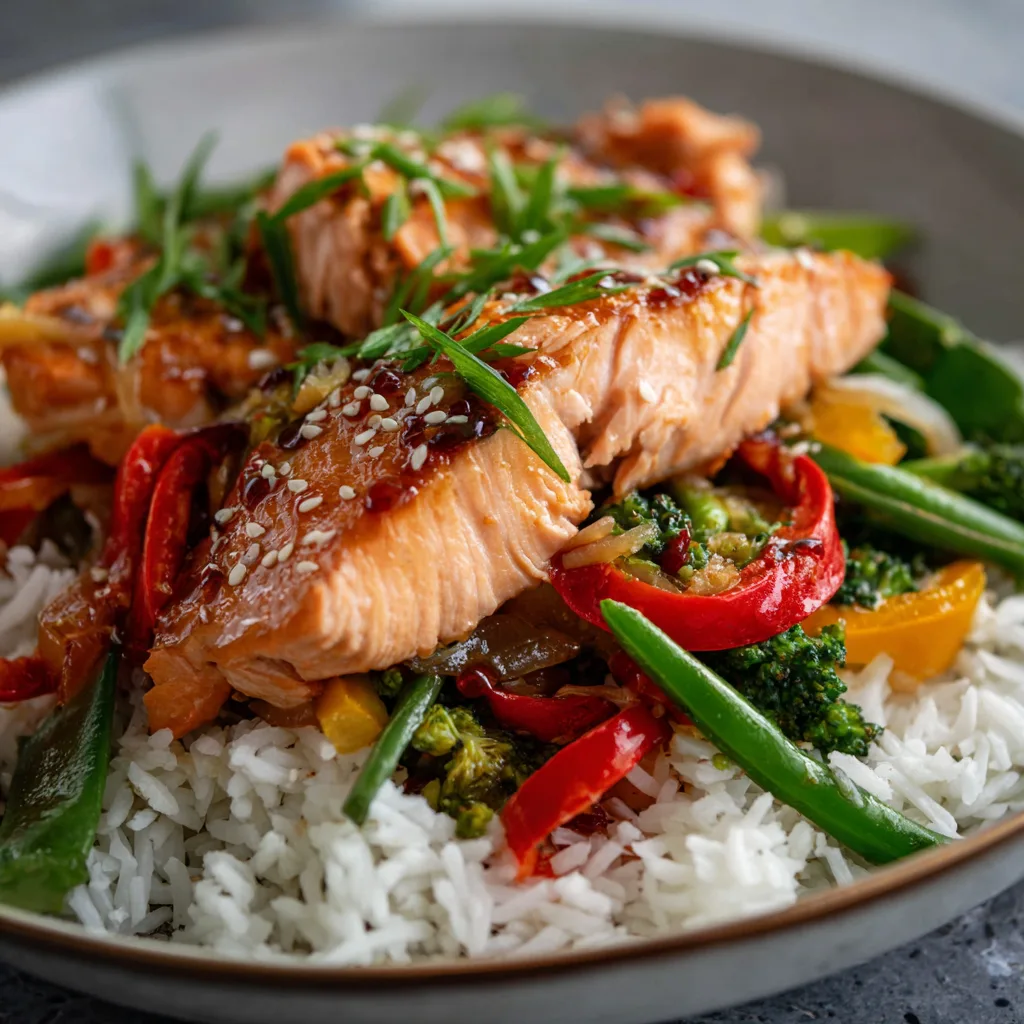Budget Slow Cooker Salmon Stir Fry: A Delicious, Affordable One-Pot Meal
Cooking tasty, healthy meals on a budget can feel challenging, especially when using premium ingredients like salmon. Yet, with smart shopping and the right method, you can enjoy this nutrient-rich fish without stretching your wallet. Choosing cost-effective cuts, frozen fillets, or seasonal deals makes salmon a realistic option for everyday dinners.
Combining the slow cooker’s hands-off convenience with stir fry’s vibrant flavors creates the best of both worlds. The slow cooker ensures the salmon stays tender and moist, while the stir fry elements bring in crisp vegetables, bold sauces, and fresh aromatics. This fusion technique lets you enjoy a dish that’s both comforting and energizing, without constant kitchen supervision.
By following this approach, you’ll save time, reduce waste, and control costs. You can prepare the ingredients in minutes, set the cooker, and come back to a wholesome meal ready to serve. The recipe works well for meal prep, family dinners, or even quick weeknight cravings. With simple tweaks, it also adapts to various dietary needs, making it a versatile choice for households looking to eat well without overspending.
This article will guide you through every step—from budget-friendly shopping tips to cooking techniques and flavor variations—so you can master a salmon stir fry that’s as easy on your schedule as it is on your budget.
Choosing Budget-Friendly Salmon Options
Salmon delivers rich flavor and nutrition, but it can be expensive without a plan. Frozen salmon often costs less than fresh, and modern freezing methods preserve taste and texture well. Thaw it overnight in the refrigerator or use the cold-water method to keep it firm and safe to eat.
Canned salmon is another affordable option, perfect for recipes where texture is less critical. It often comes pre-cooked and packed with omega-3s, making it both budget-conscious and nutrient-dense. Watch for sales on fresh fillets and stock up when prices drop. Buying in bulk and portioning at home can also reduce cost per serving. Seasonal price dips—often in late summer—are prime times to buy and freeze salmon for later use.
Affordable Vegetables & Stir-Fry Staples
Vegetables add color, crunch, and extra nutrients to salmon stir fry without raising the budget. Carrots, broccoli, bell peppers, and onions are staples that pair well with salmon’s flavor. Choose in-season produce for the best prices and taste.
Frozen vegetable mixes labeled for stir fry are a time-saver and often cheaper than fresh, especially when certain vegetables are out of season. They also cut down on prep time while reducing food waste. Combining fresh, budget-friendly vegetables with frozen blends can create variety without overspending.
Low-Cost Flavor Enhancers
Pantry staples can transform simple salmon and vegetables into a flavorful meal. Soy sauce or tamari, minced garlic, fresh or ground ginger, and a pinch of spices create a classic stir fry profile. Coconut aminos offer a budget-friendly alternative for those seeking a lower-sodium or soy-free option.
You can swap costly ingredients for everyday items without losing flavor. Use honey or brown sugar instead of specialty sweeteners. Replace store-bought sauces with a quick mix of broth, soy sauce, and seasonings. These substitutions keep your dish affordable while maintaining rich, balanced flavors.
This combination of smart protein sourcing, economical vegetables, and budget-friendly flavor boosters ensures your slow cooker salmon stir fry is as kind to your wallet as it is satisfying to your taste buds.
Why Use a Slow Cooker for Salmon?
A slow cooker is ideal for preparing salmon because it applies gentle, consistent heat that prevents the fish from drying out. This method allows the salmon to cook evenly, keeping its texture moist and flaky. Unlike high-heat cooking, which can quickly toughen delicate proteins, the slow cooker gives you a forgiving, set-and-forget approach.
Beyond texture, the slow cooker offers unmatched convenience. Once the ingredients are prepped, you can walk away and let the appliance do the work. It’s perfect for batch cooking, making it easier to portion meals for the week. For busy schedules, this means less time in the kitchen and more ready-to-heat healthy meals waiting in the fridge.
Incorporating Stir-Fry Elements into the Slow Cooker
While stir fry traditionally relies on quick, high-heat cooking, you can adapt its bold flavors to a slow cooker method. Begin with a flavorful base—broth, soy sauce, or tamari—to infuse the salmon and vegetables as they cook. Add sturdy vegetables such as carrots or broccoli early, as they can handle longer cooking times without losing structure.
Tender vegetables like bell peppers or snow peas are best added near the end to preserve their color and crunch. Stir fry sauces, made with garlic, ginger, and a hint of sweetness, blend beautifully into the slow cooker’s gentle simmer.
Step-by-Step Cooking Workflow
-
Prep the salmon: Thaw overnight in the fridge or in cold water. Cut into portion-friendly chunks for even cooking.
-
Layer in the slow cooker: Pour in your base liquid—such as broth with soy sauce—and arrange the vegetables. Place the salmon pieces on top.
-
Set the temperature: Cook on low for 1–2 hours, or high for about 1 hour, until the salmon is just cooked through.
-
Add final touches: For a texture boost, you can quickly sear the salmon in a hot pan after slow cooking. Alternatively, add a fresh batch of sauce and gently toss before serving.
Tips to Prevent Over-Cooking
Use an instant-read thermometer to check the salmon’s internal temperature. Remove it once it reaches about 145 °F for perfect flakiness. To keep vegetables vibrant, add delicate ones during the final 15–20 minutes of cooking.
Lining the slow cooker with parchment paper makes removing the salmon easier and prevents it from breaking apart. This simple step also makes cleanup faster.
With these techniques, you can enjoy a flavorful fusion of slow-cooked salmon and stir fry elements that delivers both convenience and vibrant taste in every bite
Budget Slow Cooker Salmon Stir Fry Recipe
Creating a flavorful salmon stir fry in a slow cooker doesn’t have to be expensive. This version focuses on low-cost ingredients and simple preparation while keeping nutrition high and flavor bold.
Estimated Yield: 4 servings
Estimated Cost per Serving: $3–$4 (depending on local prices and seasonal deals)
Ingredients:
-
1 lb frozen salmon fillets, thawed ($7–$8 total)
-
2 cups frozen stir-fry vegetables ($2)
-
1 medium onion, sliced ($0.50)
-
½ cup low-sodium soy sauce or tamari ($0.50)
-
½ cup chicken or vegetable broth ($0.40)
-
2 cloves garlic, minced ($0.20)
-
1 tsp fresh or ground ginger ($0.15)
-
1 tbsp honey or brown sugar ($0.15)
-
1 tbsp cornstarch (optional, for thickening) ($0.05)
-
Salt and pepper to taste
Method:
-
Prep the salmon: Thaw completely, then cut into even chunks to ensure uniform cooking.
-
Create the base sauce: In a small bowl, mix soy sauce, broth, garlic, ginger, and honey. Stir until well combined.
-
Assemble in slow cooker: Add onions and frozen vegetables to the bottom. Place salmon chunks on top.
-
Pour sauce over ingredients: Make sure each piece of salmon gets coated for maximum flavor.
-
Set the slow cooker: Cook on low for 1–2 hours or high for 1 hour, until salmon reaches 145 °F.
-
Optional thickening: In the last 10 minutes, stir in a cornstarch slurry (cornstarch + water) to thicken the sauce.
-
Serve: Gently remove salmon with a spatula to keep pieces intact. Serve hot over rice, noodles, or as a low-carb bowl.
Budget Tips:
-
Buy salmon in bulk and freeze portions for later.
-
Use frozen mixed vegetables to avoid waste and prep time.
-
Replace fresh garlic and ginger with powdered versions if needed.
Variations & Dietary Tweaks
Gluten-Free Option
Replace soy sauce with tamari or coconut aminos for a gluten-free alternative without sacrificing flavor.
Low-Carb / Paleo / Whole30 Adaptation
Use coconut aminos instead of soy sauce, skip the cornstarch, and focus on non-starchy vegetables such as broccoli, zucchini, and bell peppers.
Add-Ins and Substitutions
-
Swap salmon for canned salmon or even other budget-friendly fish like pollock.
-
Add extra frozen vegetable medley for more volume without adding much cost.
-
Mix in mushrooms, snow peas, or shredded cabbage for added texture.
Serving Suggestions
Over Rice
Serve the salmon stir fry over fluffy white or brown rice for a filling, affordable meal.
Over Noodles
Egg noodles, soba, or even spaghetti work as excellent stir fry bases. Toss them lightly with sesame oil for extra flavor.
Low-Carb Bowl
Skip the starch and serve with extra vegetables or over cauliflower rice for a lighter option.
Simple Side Pairings
Add steamed green beans, sautéed spinach, or a quick cucumber salad to round out the meal. Instant rice or microwaveable grain packs can cut prep time even further.
With these variations and serving ideas, this recipe can suit almost any taste, dietary preference, or budget—while keeping preparation easy and flavors satisfying
Frequently Asked Questions
Can I cook frozen salmon directly in the slow cooker?
It’s best to thaw salmon before cooking in the slow cooker. Cooking from frozen can lead to uneven results and increase the risk of overcooking the outside while the inside remains underdone. Thawing overnight in the refrigerator or in a sealed bag under cold running water keeps texture and flavor intact.
How long does salmon take to cook in a slow cooker?
On the high setting, salmon typically cooks in about 1 hour. On the low setting, expect 1½ to 2 hours. Check with an instant-read thermometer and remove the salmon when it reaches 145 °F to ensure perfect flakiness without dryness.
Will salmon get mushy if overcooked in the slow cooker?
Yes, overcooked salmon can lose its structure and turn mushy. To avoid this, monitor the cooking time closely. Adding delicate vegetables near the end helps keep both the fish and the veggies at their best texture.
Can I add vegetables to the slow cooker with salmon?
Absolutely. Sturdier vegetables such as carrots, broccoli, and onions can be added at the start. Tender vegetables like bell peppers or snow peas should go in during the last 15–20 minutes to preserve color and crunch.
How do I keep salmon from falling apart?
Line the base of the slow cooker with parchment paper to make lifting the salmon easier. Handle with a wide spatula to support each portion, and check doneness with a fork or thermometer rather than constant poking, which can break the fish apart.
These tips ensure your slow cooker salmon stir fry turns out flavorful, visually appealing, and cooked to perfection every time.
Budget Slow Cooker Salmon Stir Fry Recipe – Easy, Healthy & Affordable

A flavorful, hands-off meal that turns affordable salmon and vegetables into a stir-fry-style feast. This recipe balances convenience, nutrition, and taste, making it ideal for budget-conscious home cooks.
Ingredients
- 1 lb frozen salmon fillets, thawed
- 2 cups mixed vegetables (fresh or frozen)
- ½ cup chicken or vegetable broth
- 2 tbsp soy sauce or tamari
- 1 tbsp honey
- 1 tsp garlic powder
- Salt and pepper to taste
Instructions
☐ Thaw salmon completely if frozen
☐ Chop vegetables and prepare sauce mix
☐ Layer broth, sauce, and vegetables in slow cooker
☐ Place salmon pieces on top
☐ Cook on high for 1 hour or low for 2 hours, until salmon reaches 145 °F
☐ Optional: Stir-fry salmon briefly for added texture or add fresh veggies near the end
☐ Serve over rice, noodles, or vegetable base
Notes




